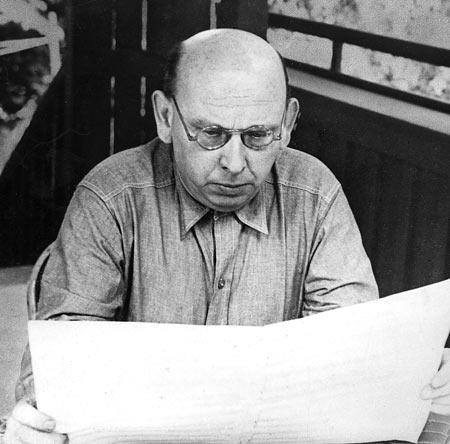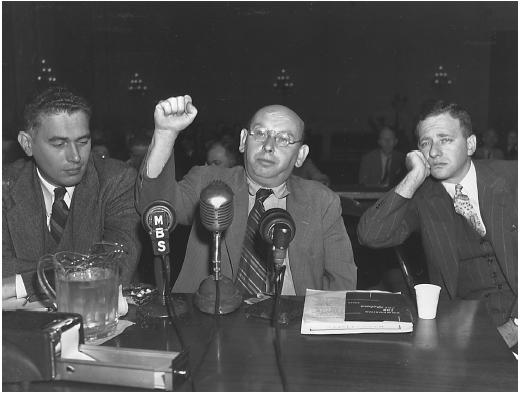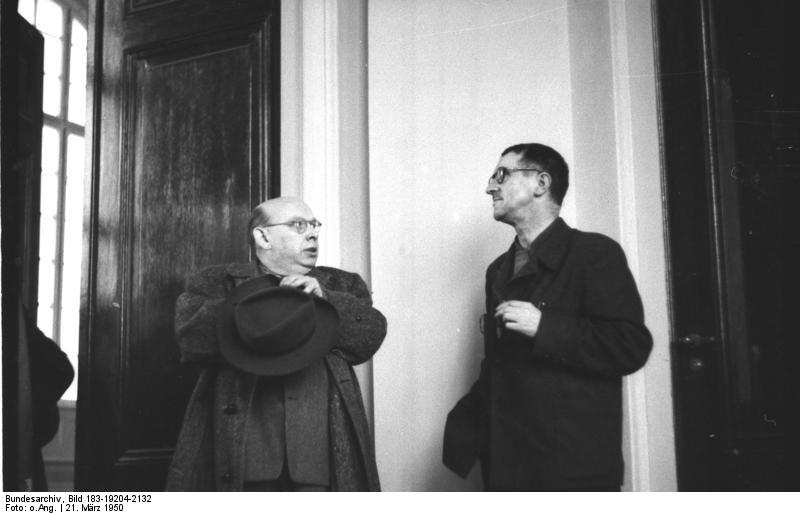<Back to Index>
- Historian and Founder of Singapore Thomas Stamford Bingley Raffles, 1781
- Composer Hanns Eisler, 1898
- 1st President of the Second Spanish Republic Niceto Alcalá - Zamora y Torres, 1877
PAGE SPONSOR
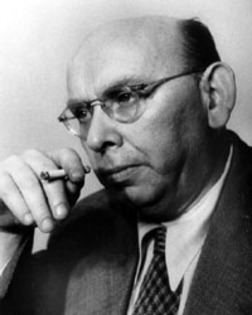
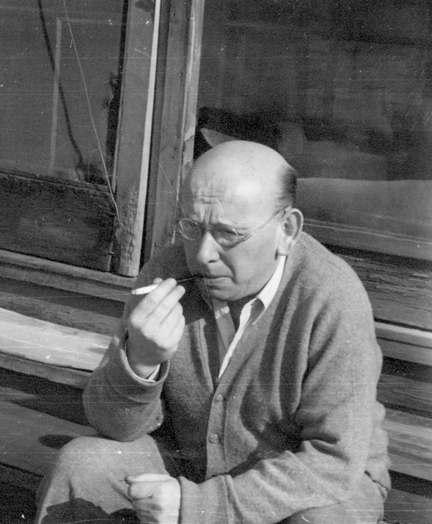
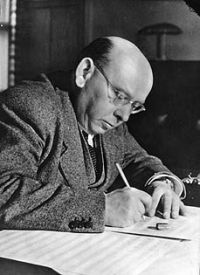
Hanns Eisler (6 July 1898 – 6 September 1962) was an Austrian composer.
Eisler was born in Leipzig where his Jewish father, Rudolf Eisler, was a professor of philosophy. In 1901 the family moved to Vienna.
His sister was Ruth Fischer (Elfriede Eisler), a leader of the German Communist Party (KPD) during the 1920s, author of several books, and from 2010, confirmed to have been a CIA spy.
His brother was the journalist and Communist Gerhart Eisler, who was believed to be a major Comintern agent operating under the cover name of Hans Berger. Louis Budenz, a former managing editor of the Daily Worker, called him in a speech in the fall of 1946 "the Number One Communist in the U.S.". Time Magazine wrote of him, "He turned up in China, charged with purging the party of spies and dissidents, sent so many men to their deaths that he was known as 'The Executioner'".
During World War I Hanns Eisler served as a front line soldier in the Austro - Hungarian army and was wounded several times in combat. Returning to Vienna after Austria's defeat, he studied from 1919 to 1923 under Arnold Schoenberg. Eisler was the first of Schoenberg's disciples to compose in the twelve - tone or serial technique. He married Charlotte Demant in 1920; they separated in 1934.
In 1925 Eisler moved to Berlin — then a hothouse of experimentation in music, theater, film, art and politics. There he became a member of the Communist Party of Germany and became involved with the November Group. In 1928, he taught at the Marxist Worker's School in Berlin and his son Georg Eisler, who would grow up to become an important painter, was born.
His music became increasingly oriented towards political themes and, to Schoenberg's dismay, more "popular" in style with influences drawn from jazz and cabaret. At the same time, he drew close to Bertolt Brecht, whose own turn towards Marxism happened at about the same time. The collaboration between the two artists lasted for the rest of Brecht's life.
In 1929, Eisler composed the song cycle Zeitungsausschnitte, Op. 11. The piece is dedicated to Margot Hinnenberg - Lefebre. Though not written in the twelve - tone technique, the piece was perhaps the forerunner of a musical art style later known as "News Items" – musical compositions that parodied a newspaper's content and style, or that included lyrics lifted directly from newspapers, leaflets, magazines, and other written media of the day. Eisler's piece parodies a newspaper's layout and content, with songs in the cycle given titles similar to headlines. The piece offers evidence of Eisler's socialist leanings, as its lyrics indicate the struggles of ordinary Germans who, after World War I, encountered hardship.
Eisler also wrote music for several Brecht plays, including The Decision (1930), The Mother (1932) and Schweik in the Second World War (1957). They also collaborated on protest songs that intervened in the political turmoil of Weimar Germany in the early 1930s. Their Solidarity Song became a popular militant anthem sung in street protests and public meetings throughout Europe, and their Ballad of Paragraph 218 was
the world's first song protesting laws against abortion. Brecht - Eisler
songs of this period tended to look at life from "below" — from the
perspective of prostitutes, hustlers, the unemployed and the working
poor. He worked with Brecht and the director Slatan Dudow on the film Kuhle Wampe which was banned by the Nazis in 1933. After 1933, Eisler's music and Brecht's poetry were banned by the Nazi Party. Both artists fled, first to Moscow, where The Decision was produced and staged. Eventually, Eisler and Brecht sought refuge in the United States, along with other exiles fleeing Nazi Germany. In New York City, Eisler taught composition at the New School and
wrote experimental chamber and documentary music. Moving shortly before
World War II to Los Angeles, he composed several Hollywood film scores,
two of which — Hangmen Also Die! and None but the Lonely Heart — were nominated for Oscars. Also working on Hangmen Also Die! was Bertolt Brecht, who wrote the story along with director Fritz Lang. In 1947, he wrote the book Composing for the Films with Theodor W. Adorno.
In several chamber and choral compositions of this period, Eisler
returned to the twelve - tone method he had abandoned in Berlin. His Fourteen Ways of Describing the Rain — composed for Arnold Schoenberg's 70th birthday celebration — is considered a masterpiece of the genre. Eisler's two most notable works of the 1930s and 40s were the monumental Deutsche Sinfonie (1935 – 57) — a choral symphony in eleven movements based on poems by Brecht and Ignazio Silone — and a cycle of art songs published as the Hollywood Songbook (1938 – 43). With lyrics by Brecht, Eduard Mörike, Friedrich Hölderlin and Goethe, it established Eisler's reputation as one of the twentieth century's great composers of German lieder.
Eisler's promising career in the U.S. was interrupted by the Cold War. He was one of the first artists placed on the Hollywood blacklist by the movie studio bosses. In two interrogations by the House Committee on Un-American Activities,
the composer was accused of being "the Karl Marx of music" and the
chief Soviet agent in Hollywood. Among his accusers was his sister Ruth Fischer, who also testified before the House Committee that her other brother,
Gerhart, was a major Communist agent. The Communist press denounced her
as a "German Trotskyite." Among the works that Eisler composed for the
Communist Party was the "Comintern March", "The Comintern calls you /
Raise high Soviet banner / In steeled ranks to battle / Raise sickle
and hammer." Eisler's supporters — including his friend Charlie Chaplin and the composers Igor Stravinsky, Aaron Copland and Leonard Bernstein — organized benefit concerts to raise money for his defense fund, but he was deported early in 1948. Folksinger Woody Guthrie protested the composer's deportation in his lyrics for "Eisler on the Go" — recorded fifty years later by Billy Braggand Wilco on the 1998 Mermaid Avenue album.
In the song, an introspective Guthrie asked himself what he would do if
called to testify before the House Committee on Un-American Activities,
"I don't know what I'll do, / I don't know what I'll do / Eisler's on the come and go / and I don't know what I'll do." On 26 March 1948, Eisler and his wife departed from LaGuardia Airport flying to Prague. Before he left he read a statement: "I
leave this country not without bitterness and infuriation. I could well
understand it when in 1933 the Hitler bandits put a price on my head
and drove me out. They were the evil of the period; I was proud at
being driven out. But I feel heart - broken over being driven out of this
beautiful country in this ridiculous way." Eisler returned to Germany and settled in East Berlin. Back in East Germany, he composed the national anthem of the German Democratic Republic, a cycle of cabaret - style songs to satirical poems by Kurt Tucholsky, and incidental music for theater, films and television. His most ambitious project of the period was a modern opera on the Faust theme. The libretto, which he published in 1952, portrayed Faust as an indecisive person who betrayed the cause of the working class by not joining the German Peasants' War. This interpretation was attacked by the official GDR press and even by Walter Ulbricht and was refused authorization by a cultural commission summoned specially for the case by the Berlin Academy of Arts.
All of these disapproved of the negative depiction of Faust as a
renegade and accused the work of being "a slap in the face of German
national feeling" (Neues Deutschland) and of having "formalistically deformed one of the greatest works of
our German poet Goethe" (Ulbricht). Disheartened, Eisler stopped work
on the music for the opera and it was never completed. Ironically, less
than five years after his deportation from the United States, Eisler
was again forced to testify in hearings where his political loyalty was
questioned. Although he continued to work as a composer and to teach at the East Berlin conservatory,
the gap between Eisler and the cultural functionaries of East Germany
grew wider in the last decade of his life. During this period, he
befriended musician Wolf Biermann, whose critical attitude towards the GDR government later led to exile in West Germany. Eisler
collaborated with Brecht until the latter's death in 1956. He never
recovered completely from his friend's demise and his remaining years
were marred by depression and declining health. He died of a heart
attack (his second) in East Berlin and is buried near Brecht in the Dorotheenstadt cemetery.
